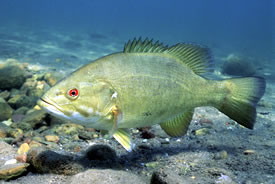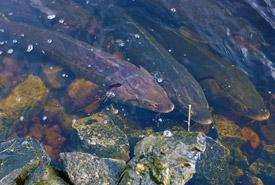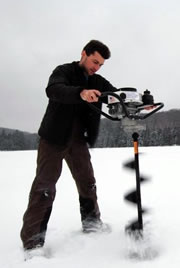Principles for ensuring healthy and productive freshwater ecosystems that support sustainable fisheries

Smallmouth bass (Photo by USFWS, Eric Engbritson)
As a postdoctoral fellow at Carleton University, I led the development of a review paper by a group of leading Canadian freshwater researchers. Our aim was to provide a summary of the best available science on freshwater ecosystems to guide development and implementation of policies protecting freshwater fisheries and habitats.
This paper was selected as the Editor's Choice article for the journal Environmental Reviews, and made available as open-access.
Below is a summary of key principles from the paper using fish as an example, but they generally apply to all aquatic organisms, including plankton, insects, crustaceans, mussels, reptiles, amphibians, birds and mammals:
Food chains transfer energy to fish, but some energy is lost at each link
Fisheries represent renewable resources and the amount of biological resources that an ecosystem can produce is limited by the energy that it receives. This energy may come from the sun or in the form of plant and animal matter from surrounding ecosystems. Energy is lost as it travels up the food chain.
Populations are regulated by reproduction, mortality and growth
Fishes are constantly exposed to stress. For example, they may face unfavourable conditions, predators, parasites or limited food sources. In combination, these can force fish to spend energy on surviving, rather than on growth and reproduction. If many individuals deal with a major stress, the size of a population can decrease through both death and/or a lack of reproduction.
Fish population size depends on habitat quantity and quality
Larger habitats can support more individuals and may contain a higher diversity of habitat types that support a wider range of species. Higher quality habitats can produce more individuals because growth rates are higher and fish are more likely to reproduce successfully. We need to maintain a wide range of healthy habitats to support all of the species in the aquatic food chain.

Lake sturgeon (Photo by Eric Engbretson, courtesy of USFWS)
Habitats need to be connected so that fish can find food and spawning grounds
For fish to complete all stages of their life cycle, they must be free to move among habitats. A common example of how this can be hampered is when dams or culverts block salmon from migrating to their spawning grounds. Levees can also prevent access to seasonal spawning grounds like floodplains. Fish ladders can help fishes move across barriers but are not always effective, especially for species that they were not designed for. Anything we can do to reduce barriers to fish movement will help all species access the habitats they need at each stage of their lifecycle.
Freshwater species and their habitats are linked to surrounding watersheds
Watersheds are vitally linked to water bodies. They provide nutrients and energy, which make their way to the water through runoff (when rain travels over land to the water). Nutrients are important for the growth of aquatic species. Changes to land use, including deforestation and urban development, have major effects on water bodies downstream. Changes to riparian zones, the area of land immediately beside the water, can have the greatest effects because this area acts as a buffer between watersheds and aquatic systems, and can slow and filter runoff. To protect aquatic habitats, we also need to protect the lands that surround them.
Biodiversity helps ecosystems deal with change and stress
Protecting biodiversity not only promotes the survival of species but has many benefits to the environment as a whole. Each species and population uses different resources in the system, and may provide resources to other species. The different species in an aquatic system have evolved together, in part because each makes sure that the others do not take over and use all of the resources. This competition leads to stability in the ecosystem, and keeps it from changing dramatically when a stress occurs. Just as our cities have backup power generators and detour routes in case of emergencies, similar species in an ecosystem act as backups for each other. When one species declines, another can increase in population to fill the gap that was left, often preventing major changes to all other species in the food web.
Local systems are affected by regional and global change
To manage and protect local water bodies and the fishes they contain, changes occurring beyond the watershed must also be considered. Pollutants like heavy metals and acid rain can be carried across regions, and many are now found even in remote lakes and rivers. Climate change is having many effects on aquatic systems, with changes to temperature perhaps being most strongly felt by freshwater species. We must account for these larger changes when working to protect local fish populations and habitats.
Fish face many stresses that layer on top of each other
The different stresses that fish face do not act in isolation. As temperatures warm, habitats are lost or changed, movements are blocked by dams and levees, toxins are deposited and nutrient levels are climbing higher than some systems can handle. We are beginning to understand how individual changes affect ecosystems, but we know little about how they act together to change things overall. Small changes that alone would have little effect can combine to create a major change. For instance, the construction of one dock on a lake would likely do little damage, but if the entire lakeshore is transformed to lawns and cottages, too much habitat is lost.
Our actions can affect the evolution of fishes, making changes difficult to reverse
Native populations have the advantage of adapting over thousands of years or longer to thrive in the unique conditions where they occur. We are rapidly changing the nature of our native fish populations by changing the processes through which they evolve. These changes are worth working to prevent, because a loss of genetic diversity is a loss of biodiversity that is hard to reverse. When changes lead to slower growth and smaller fish that mature earlier, the overall resources that a fishery provides is reduced, limiting the sustainable benefits that it provides.


